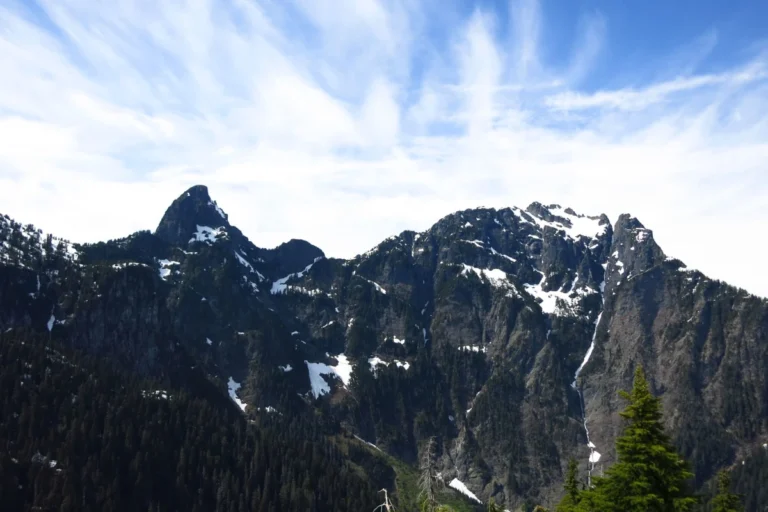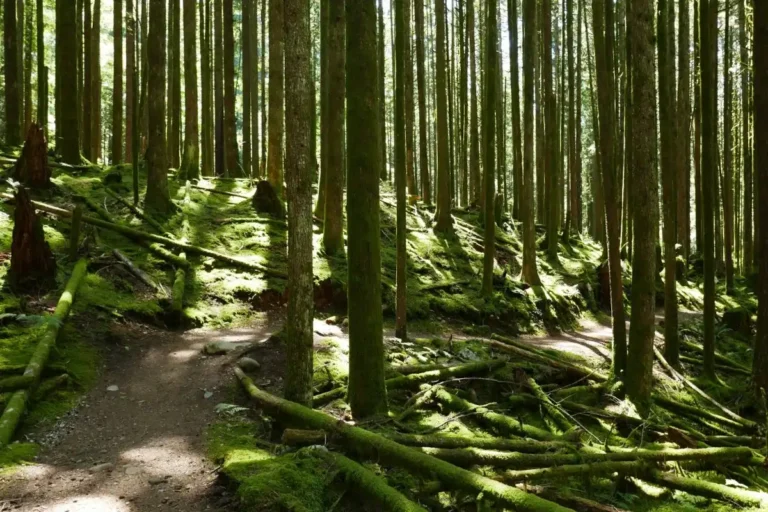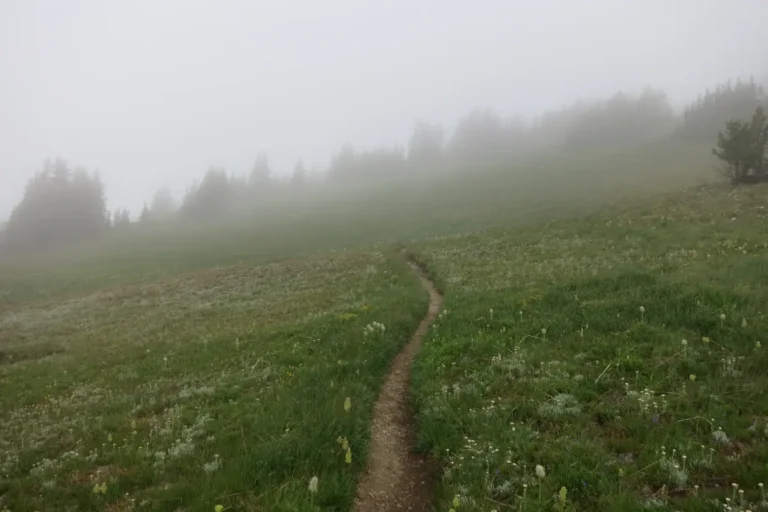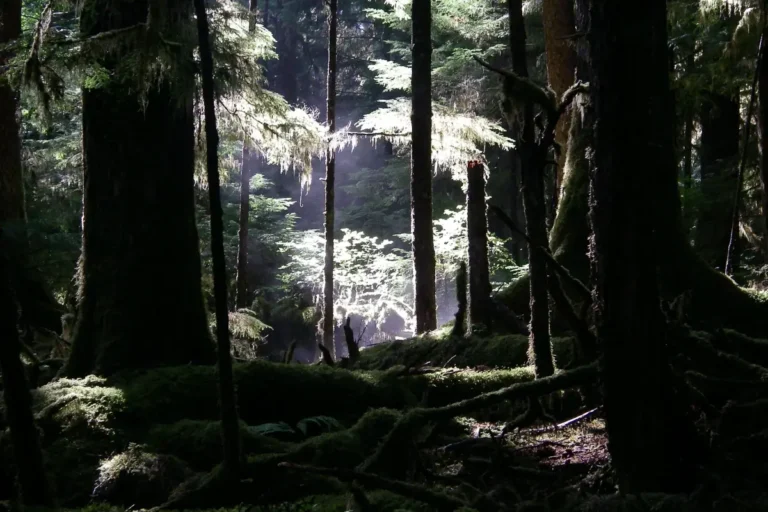Fear of Heights on the West Coast Trail
They said if you were hiking solo on the West Coast Trail, to always make sure that you were in the middle of the pack, never last to arrive at camp. After getting off the boat from Gordon River, my fellow hikers were merrily climbing up the first ladder, thirty-five rungs of near-vertical hell. Hanging back, I was quietly freaking out about the nemesis before me. For months since booking the trip, this ladder had tormented my worst nightmares. What if I freeze up halfway? What if my pack is too heavy and it drags me off backwards? What if I slip while climbing up?
What had never occurred to me in all my imagined scenarios was that I might just shake myself right off the ladder with pure terror. As I began to climb, it was suddenly a very real danger, because I was shaking so badly that I thought my hands and feet would slip off the rungs. By the time I reached the top, I was gasping in breathless horror on top of the shaking, and in my own words, I thought I was going to have a bleeping heart attack.
One might wonder why someone who is afraid of heights might tackle something like the West Coast Trail, which apart from being relatively flat elevation-wise, is chalk full of heights in the form of ladders and bridges. I can’t speak for anyone else, but for myself, I might be a chicken, but I’m a damned stubborn one. I wanted to do the trail, therefore I’d have to figure out a way to deal with the heights part of it.
I refuse to live my life scared. I’ve done that. After a car accident in 2011, I lived in fear of the world killing me for half a decade. Every time I walked out my door, I was internally bombarded with an extensive list of everything that could go wrong and every horrible thing that could happen to me. Conquering it was a painstaking process driven by the desire for the ultimate control over my own mind and fear, and to escape the personal hell that my own brain had created for me.
Being afraid of heights is different than being afraid of the world killing you in various ways. For one, the fear of heights for me is a phobia, one which I can trace back to being terrified on the yellow chair at Hemlock Valley Ski Resort when I was four or five years old. The thing about it is that I can look at a photo of something and think to myself, yeah I can do that … right up until I’m two metres off the ground. Then it’s like a switch flips in my mind, activating my monkey brain. Several things can happen then: I freeze up completely, or I get low, often dropping to my hands and knees and crawling. I start shaking and I get unsteady with vertigo, wobbling around like Jack Sparrow. At the same time, there’s a horrible, awful sensation in my body that whatever I’m standing on is dropping out from beneath my feet. I can’t express enough how absolutely terrible that is. Then there’s the call of the void. A yawning sensation that’s sucking me down. Despite knowing that looking down will worsen all of that, I’ll have the overwhelming urge to look down. Even if I override the urge and don’t look down, my body still knows it’s up high, and one or all of those things happen anyway.
Getting up the first ladder was an accomplishment, and once I ascertained that I was not, in fact, having a heart attack, I was certainly not going to go back down that horrible thing. That left only one direction: onwards. I pulled out my hiking poles and set off on my merry way down the rooty, rough trail and into the woods.
There were more ladders that day, but surprisingly, while still scary, they just didn’t seem like as much of a problem after that first one. One of the things I quickly found out was that it was actually easier to go up the ladders rather than down, because when you’re going up, you’re looking up, not down. You see, the key to getting through it is to not look down. I want to look down. I have an overwhelming urge to look down. It takes an incredible amount of mental fortitude to not do it.
As I said, I’m stubborn.
By the time I reached the ladders at Thrasher Cove I was so jacked up on endorphins that I just went ahead and shakily did them without much thought, elated to be through with my first day on the trail and looking forward to a meal. I hated every terrified second of being on those ladders, but I was so proud for getting through each and every one of them.
My next challenge height-wise came on day three, when I hiked from Camper Bay to Walbran Creek. This section had it all: slippery boardwalks, swamps, mud, numerous ladders … and a suspension bridge over Logan Creek. The suspension bridge, according to veteran WCT backpackers online, was an improvement from a set of ladders had previously been there.
Over the winter, I’d seen photos of the new suspension bridge on the West Coast Trail Facebook group I was in. Someone working on it had posted photos of the construction, and I’d regarded it with horror, almost in tears as I completely wigged out over the pictures. It was a thing of absolute nightmares. I’d blindfold myself, I decided, until I voiced this to my mother, who told me that was a really dumb thing to do.
To prepare for it, I went out and practiced walking across a local suspension bridge and managed to get across by focusing on a point on the far side and not taking my eyes off it. It was incredibly difficult to do because I had to override the urge to look down, and my brain still knew that it was up high. I hated every second of walking across that bridge. I could get across, though. At any rate, turning back at Logan Creek wasn’t going to be an option, so I figured I’d just make it across one way or another. What other choice was there? Sit there and grow moss like a tree? Nah.
Before the bridge, though, there were ladders. The day was the stuff of nightmares, and Cullite Creek was the worst. Midway down the set of eleven ladders going down, I felt my mental fortitude begin to crack. I was barely hanging onto the ability to ignore and override my symptoms, the shakes coming back, my breath ragged. To get through it, I deployed a tactic I’d learned from managing symptoms of post-traumatic stress: reciting the alphabet backwards.
Reciting the alphabet backwards is a very effective tool for handling an oncoming anxiety attack, because you have to think about it just enough to be able to distract yourself. For minor panic, I liked to do the same thing but without the alphabet: I’d simply mentally block myself from acknowledging the fear. I could feel that blocking ability crumbling on those ladders, though, so I deployed the alphabet tactic. With gasping, shaky breaths, I recited the alphabet out loud, backwards, probably sounding like a total loon. But it got me down those ladders.
Of course, then I had to go up. There were seven more to go.
I was mentally exhausted, and an additional complication arose as I started up the first one. I’d run into that time of day when the southbound gang was coming through, so I wound up pausing on the platforms between the ladders while waiting for people to come down, which was terrible because the platforms were small and high. I’d get vertigo if I looked down, which just wouldn’t do while climbing ladders. So I clung to the railings for dear life instead while I waited my turn.
Once again, I got through it. After a short break to eat and chat with some fellow hikers, I moved on down the trail, into the bogs and forests, a little giddy, all the while knowing that the suspension bridge lay ahead. And suddenly, there it was.
It was less horrible than the photos I’d seen, because in the photos the sides hadn’t been put on it yet, but it was still truly awful. Because it feels better to hang onto something and helps with any vertigo that might make an appearance, I grabbed the cabled sides of the bridge, or tried to. Unfortunately, they were new and scratchy, and some metal fasteners attached to them meant that I had to skim my hands along them rather than hanging for dear life like I really wanted to.
I started out with my eyes on the top of a tree on the other side, just like I’d practiced, but of course my brain wasn’t fooled. It knew as soon as I was over the void, and having received those danger signals, it activated a response: freeze. When that happens, I literally have to force every step, like a dream where you’re trying to run but your legs just won’t move. At that point, the urge to look down had chimed in, but I repeated my mantra: don’t look down. If I looked down, I’d drop down low and wind up crawling across the stupid thing. Been there, done that. Embarrassing.
Talking myself through each half-frozen step wasn’t enough. So I adjusted my gaze from the top of the tree to the end of the bridge, and with my goal in sight, was able to finally get moving. Feeling absolutely ridiculous, I encouraged myself across, running the final distance with my arms straight out at my sides like some kind of demented bird.
I was still gasping for breath and terrified. But I got across.
The worst part of the trail was over. There were more ladders, of course, up and down the cliffs as the trail wound on and off the beach. The worst ones were the ones where there was a void between the ladder and the cliff. It was always better when the ferns and bushes were right there. I learned to expect ladders at every creek crossing. None were as bad as Cullite, and by the time I got to Tsusiat Falls, the ladders were a conquerable problem, which was a good thing, because unless I wanted to drink water that everyone was swimming in, I had to go back up the ladders and down the trail to reach the creek. After a few times going up and down, I almost felt like one of those people who wasn’t afraid of heights. Later in the day I watched someone else struggle coming down for almost an hour and silently cheered her on. If I can do it, you can do it.
On the northern part of the trail, the ladders weren’t so bad, shorter for the most part. One of the other backpackers I hiked with for awhile had a map that showed how many rungs were on the ladders ahead. There was a sixty-something rung ladder ahead, they told me the one day. Oh hell no. But yes. Yes there was. There were a few big ones, in fact, including a really terrible one near Tscowis. I sang a stupid song up and down the things, hating it, feeling like a badass.
The cable cars, surprisingly, weren’t much of a problem. That was because pulling myself across solo was so difficult that I didn’t have much time to look down as I was inching across and cursing myself. I also went at a very dry time of year, so most I could skip altogether and the vast majority of the others I had help in the form of other hikers. It was the ladders that required the most mental fortitude.
Just before the end of the trail, there was a junction, one path going the beach way and the other going the forest way. Since I love the woods best of all I chose the forest way … and almost immediately came to one last huge, long ladder. I climbed a couple of rungs and then looked up at the thing in disgust and exasperation. Seven days in and I was so over it. I was so annoyed by this one ladder that I just couldn’t even deal with its shit. I backtracked and took the beach instead.
Over that week, the ladders had became a sort of analogy for life: you can’t move forward unless you do the hard thing that you’re scared of. Don’t get stuck at the bottom of the ladder. You have to climb it. Yes, it’s hard, but you can’t just sit there. You’ve got to do it. There’s no other way.
I set out on the trail to prove that I had conquered the mental torment that had plagued me since my car accident. And I did. On the West Coast Trail, I finally felt like I’d gotten a boot on the neck of that torment. I learned that so long as I kept going into the wild, I would be unconquerable.
I learned to climb ladders.
Want tips for managing fear of heights on the West Coast Trail? Read on here!






